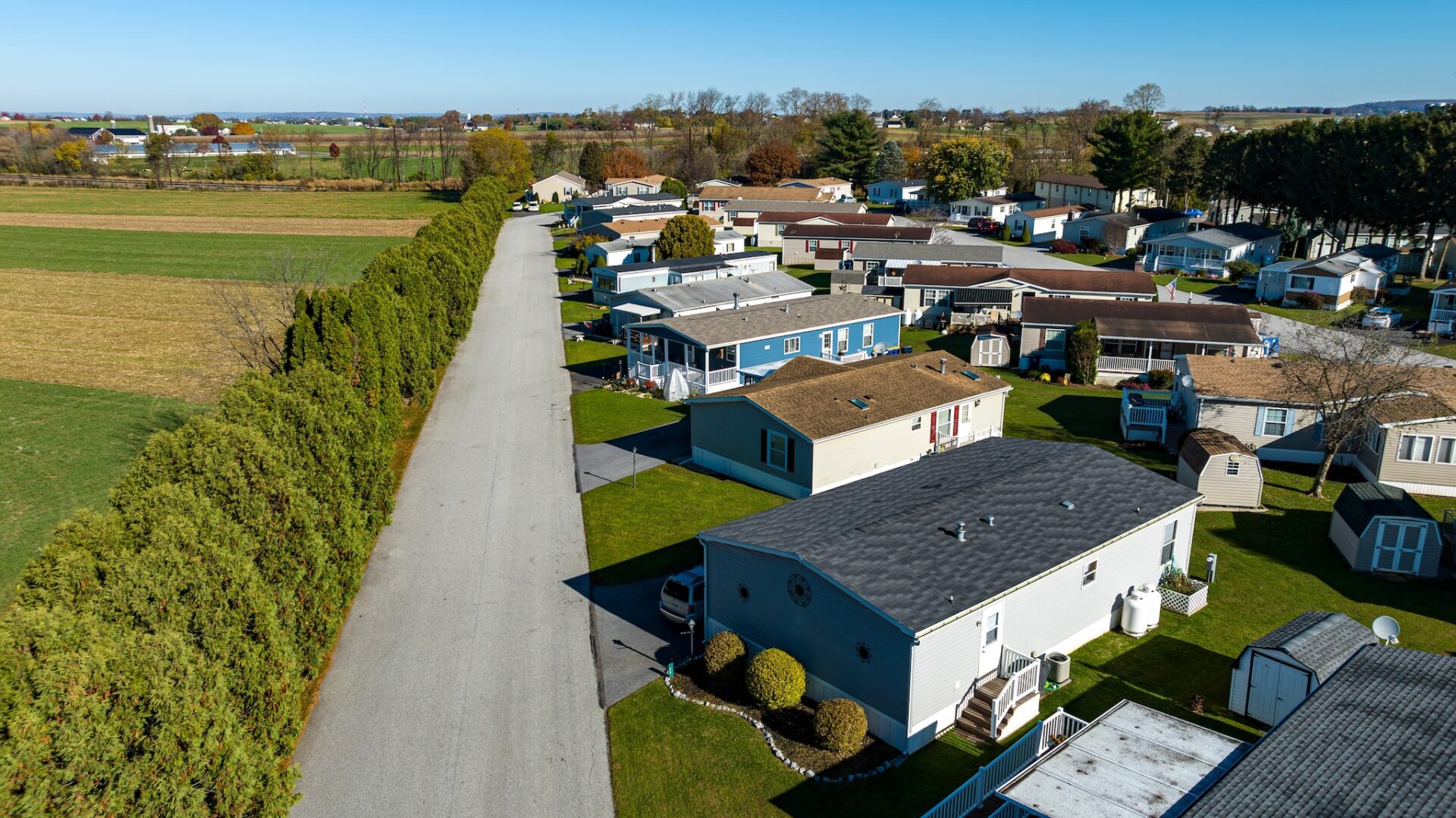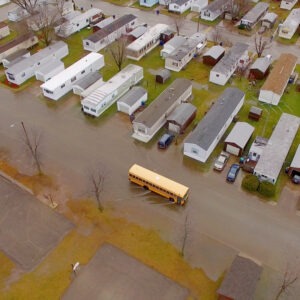Mobile home parks are a critical source of affordable housing in the United States. They also tend to face higher flood risks than other types of housing. People who live in mobile homes are more likely to have social vulnerabilities that may make them less likely to be able to prepare for, respond to, or recover from a flood. Yet mobile home parks are frequently overlooked in emergency management planning and mitigation projects, putting millions of Americans’ lives and property on the line as damaging flood events increase in frequency and severity.
Communities can reduce flood risks in mobile home parks in many ways, including elevating homes, building infrastructure to protect the park, improving stormwater drainage systems, elevating and securing utilities, and creating detailed evacuation plans. When flood risk is extreme, relocating the mobile home park through a property buyout or acquisition may be the best option.
To date, there has been little research on mobile home park buyout projects. It is unclear how common they are, where they have occurred, or the long-term outcomes for impacted residents. For local governments, there are no guides for how to plan and fund mobile home park buyouts, though the people who live in mobile home parks often have distinct needs that must be addressed. At the federal level, buyout programs aimed at assisting communities are not designed to meet the unique challenges facing mobile home parks.
To begin answering these questions, Headwaters Economics researched mobile home park buyout projects across the country and identified 12 projects that are either completed or in progress. Each project was costly, with expenses ranging from $3 million to more than $10 million, and many of the projects required a complex mix of local, state, and federal funding. Many of the projects required more than 10 years to plan and implement.
The 12 projects shed light on the challenges facing communities that are attempting to protect mobile home park residents through buyout projects. They also point to buyout program reforms that state and federal agencies can apply to achieve better outcomes for residents of mobile home parks in areas with extreme flood risk. Below we summarize the common challenges facing communities that are undertaking buyout projects to protect residents. Two of the case studies that included particularly compelling innovations in prioritizing people and relationships are described in detail. We conclude with policy reforms that local, state, and federal agencies can pursue to achieve better outcomes.
What are property buyouts for flood mitigation?
Flood buyouts are initiated by state and local governments and give property owners an option to move away from areas with high flood risk. For the most common type of buyout project, structures are demolished after they are purchased, and restrictions are established to prevent future development. While property buyouts are effective at decreasing flood risk and restoring floodplains, buyout programs have been criticized for being too complex, inflexible, and time intensive, as well as failing to address the needs of socially vulnerable communities. More info.
How are property buyouts funded?
The primary funding for flood mitigation buyouts and acquisitions comes from the Federal Emergency Management Agency and the U.S. Department of Housing and Urban Development, though the Army Corps of Engineers and U.S. Department of Agriculture also manage programs that can provide support. Some states, including Vermont and North Carolina, as well as some localities such as the City of Houston, have created their own buyout programs to further their flood mitigation goals.
Subscribe to our newsletter!
Why buyouts are often problematic for mobile home parks
Federal buyout programs have been criticized for their complexity, long time frames , and overemphasis on technical and economic criteria, leading to inequitable processes and outcomes. For several reasons, these programs can be particularly ill-suited for mobile home residents who do not own their land or have older homes:
- Many mobile homes are titled as personal property as opposed to real property. This means the standard methodology for calculating home values cannot be used, requiring federal agencies to calculate buyout amounts on a case-by-case basis.
- Buyouts are negotiated with the property owner of a mobile home park as opposed to the residents. When the needs of mobile home park residents are not prioritized, there is a high risk that a buyout will displace residents against their will, upending social networks, employment status, and more.
- Low-value homes like mobile homes may be targeted for buyouts. Federal program requirements, including benefit-cost calculations and substantial damage thresholds, can make it harder for mobile homes to qualify for alternative mitigation measures compared to buyouts. Buyouts should be chosen as the solution only when it is necessary.
- Buyout payments may not cover the full cost of moving. Buyout amounts are based on pre-flood fair market values of land and homes, which can be low for mobile home owners who do not own their land. While mobile home park residents may be eligible for additional rental and relocation assistance, the buyout payment does not always cover the full costs of purchasing a new home and relocating – particularly if there are deductions from the payment due to duplication of benefits.
- Buyouts have additional program requirements when mobile homes are involved. Mobile home park residents are often designated as involuntarily displaced and therefore qualify for Uniform Relocation Assistance funding from FEMA. While this is an important source of aid for impacted residents, it adds complexity to the project and also cost. In some instances, the additional cost may make it harder to design a project that is “cost effective” according to FEMA’s standards.
- Poor documentation of previous flood damages to mobile homes can impede buyout applications. Previous flood damages to mobile homes are not always well documented, making it challenging to provide sufficient documentation to justify the buyout project.
- Many mobile homes cannot be moved. Despite the name, many mobile homes cannot be easily relocated due to a lack of structural integrity or because the cost is too high. As a result, when a park is closed mobile home owners are often forced to abandon their homes, losing both their shelter and their equity. For homes that can be moved, finding a new park can be challenging due to exclusionary zoning and land use regulations, low vacancy rates in other mobile home parks, or park regulations that prohibit certain types and ages of homes.
Clearly, federal buyout programs are not designed to meet the unique needs of mobile home park residents. Nonetheless, for mobile home parks with extreme risk, a buyout may be the best option to protect people and property.
Overcoming buyout barriers with local and state innovation
The 12 flood buyout projects we researched highlight a wide range of innovative strategies that local and state governments have taken to overcome buyout barriers, including identifying creative funding sources and implementing people-focused relocation plans. The interactive map below shows the locations of each case study. Mouse-over each location to view a high-level description of partnerships, funding sources, and project status.
Below, two of the 12 projects we examined are highlighted because they stand out for their re-imagining of the buyout process to prioritize people and relationships.
ADDRESSING THE RELOCATION FUNDING GAP
Brattleboro, Vermont: Tri-Park Cooperative (26 mobile homes)
The Tri-Park Cooperative is Vermont’s largest and oldest resident-owned community, providing housing for nearly 10% of Brattleboro’s population. However, the cooperative faces dual challenges of failing infrastructure and substantial flood risk. Its vulnerability to flooding was demonstrated in 2011 when Tropical Storm Irene led to 20 homes being flooded and lost.
In response to these challenges, the Cooperative’s board partnered with the City of Brattleboro, Windham Regional Planning Commission, and the State of Vermont to improve water and sewage systems and relocate 26 mobile homes in the floodplain to a safer section of the park. As part of the $7.9 million relocation project, residents will be given new energy-efficient homes. The project leverages funding from the Vermont Homeowner Tax Credit, HUD Community Development Block Grant program, Vermont Housing and Conservation Board, the Vermont Housing Finance Authority, and the Vermont Flood Resilient Communities Fund. Vermont’s Flood Resilient Communities Fund stands out as an innovative example of how states can design programs to meet the needs of mobile home residents. Since mobile home park buyout programs may struggle to qualify for federal funding, Vermont’s Flood Resilient Communities Fund can be used to ensure that residents are not left behind. The fund was originally created with one-time COVID-relief aid but is now being funded with general operating budget funds.
EXPERIMENTING WITH A BUYOUT THAT KEEPS PEOPLE IN PLACE
Boulder, Colorado: Ponderosa Mobile Home Park (68 mobile homes)
The Ponderosa Community Stabilization Project in North Boulder, CO, is a different type of property buyout. While the project includes buying out mobile homes, the relocation of residents is occurring on site in new homes that are being built with additional flood mitigation measures.
After the 2013 flooding severely impacted the Ponderosa Mobile Home Park, the City of Boulder received a HUD Community Development Block Grant – Disaster Recovery (CDGB-DR) to engage with residents to identify a solution. During these meetings, residents stated that they did not want to move, and the resulting plan that the city created reflected that goal. In 2017, the City of Boulder began implementing the long-term vision for the park and purchased the property. The city then invested more than $3 million to address the backlog of deferred maintenance to the park’s water and sewer systems.
In addition, the city purchased 48 mobile homes and replaced them with single-family homes, duplexes, triplexes, and fourplexes that are being built by Habitat for Humanity. Mobile home residents have first right to purchase and the city is providing downpayment assistance. While many of the new homes are still in the floodplain, the city has built them to meet floodplain elevation requirements and, when possible, the city has completed smaller mitigation projects to help decrease the flood risk. Further, the city purchases flood insurance on behalf of the households to mitigate risk and ensure affordability.
These stories illustrate the investments in time, resources, and relationship building necessary to address flood risk in mobile home parks. For many rural and low-capacity communities, these types of projects are out of reach due to their complexity and costs, but knowledge sharing and reforms at the state and federal levels can help change that.
Recommendations for policymakers
As flooding has become more frequent and severe, mobile home parks are increasingly impacted – often with devastating outcomes for residents. Yet, addressing the flood risk to mobile home parks is often too complicated and expensive for local governments to solve on their own, particularly for smaller or lower-capacity communities. Partnerships between local, state, federal, private, and nonprofit stakeholders are required. We recommend:
For local governments
- Identify mobile homes at risk and track flood damages. Create an inventory of mobile home parks and how many mobile homes within each park have flood risk. Track and document damage to mobile homes when floods occur, even if a federal disaster is not declared. Work with mobile home park owners and property managers on evacuation plans for residents and their pets.
- Engage with mobile home residents in person and on site. Community engagement with mobile home park residents can be challenging as residents may have little time for involvement, may not trust outsiders or government staff, and may not prioritize flood risk as a central problem in their day-to-day lives. Engaging in person and on site at the mobile home park is necessary to build trust.
- Design projects that account for and address residents’ social and economic vulnerabilities. Mobile home residents have unique vulnerabilities due to demographic and socioeconomic status, their split ownership and, for some, the way their home was financed. Buyout information may need to be communicated in multiple languages, and solutions should focus on ensuring people are safe and have secure housing.
- Leverage diverse funding. The projects identified in this analysis relied on a mix of local, state, federal, and private funding. After a mobile home park is bought out, the land is typically deed restricted and therefore becomes a potential site for floodplain and wetlands restoration. This opens the possibility of pursuing non-traditional sources of funding such as grants for state parks and recreation.
- Hire a project manager to focus on the buyout project. Relocation projects involving mobile home parks are complex, often take years, and can involve large numbers of residents. Projects may involve multiple federal agencies and often a diverse set of funding sources. Having a point person to manage the project can ensure that the local government has capacity to plan and implement the project. Some federal grants cover management costs to pay for necessary positions.
For state and federal agencies
- Create mobile home park databases that include information about the number of pads with flood risk. Few centralized data sources detail how many residences within mobile home parks have flood risk, making it hard to implement policy solutions. States that have created mobile home park databases, such as Vermont, have leveraged the data to make a case for building mitigation programs that better meet the needs of mobile home parks. A national database could also assist states and help guide federal policy implementation.
- Exempt Uniform Relocation Assistance payments from the benefit-cost analysis. Additional aid that is needed to ensure equitable outcomes for community members should not unintentionally penalize projects in federal scoring processes.
- Expand funding for proactive mitigation projects. Most funding for buyouts becomes available after a disaster, and there is a need for local governments to be more proactive. Further, planning and implementing mitigation projects that prioritize equitable outcomes requires more stakeholder engagement across government agencies and within communities and thus requires more funding.
- Invest in programs, technical assistance, and funding specifically for mobile home parks. Mobile home residents face both real and perceived barriers to accessing federal funding. Residents with split ownership occupy a grey space of being both a renter and an owner, which makes it difficult to determine eligibility for federal programs. State and federal agencies should directly address mobile home residents in their mitigation and disaster recovery programs, making it clear how they access resources. For example, the Harris County Post Disaster Relocation and Buyout Program has FAQs for mobile home residents and a fund to help low-income residents and undocumented workers.
- Track outcomes for mobile home residents. Currently, there is no research on whether mobile home residents are better off after relocating away from the floodplain. This data gap makes it challenging to improve property buyout policies to better meet the needs of mobile home residents.
Relocating a mobile home park to protect a community from floods may not be the first choice of residents or local leaders. As highlighted in this research, mobile home park buyouts are often expensive, time consuming, and require extensive community engagement to prevent inequitable outcomes. Nonetheless, for some communities, it is the choice that best keeps people and property safe.
As flood risks rise, more communities will consider buyout programs and it will be vital that local, state, and federal agencies appreciate the unique needs of mobile home park residents and the complexity of these approaches. State and federal changes to flood buyout and mitigation programs can make them more applicable to mobile home parks, strengthening efforts to increase flood resilience while investing in affordable housing.
Methods
Headwaters Economics used state and federal documents as well as input from hazard mitigation experts to identify mobile home park buyouts across the United States. We identified 12 mobile home buyout projects initiated since 1990 with diverse funding sources. Local government officials were interviewed for additional information.
Definitions
In this post, we use the phrase “mobile homes” to refer to all manufactured homes, but this is an increasingly outdated term. From a technical stance, mobile homes are manufactured homes that were built before 1976 when HUD began regulating their construction, design, and installation. We use “mobile homes” in this post both for simplicity and because many of the homes involved in buyout projects predate the HUD regulations.
The terms “buyouts” and “acquisitions” are used interchangeably in this post, as they are by practitioners and many state governments. However, there is a distinction within federal programs. Buyouts are a type of acquisition project that requires that the land be kept as open space, such as a park, after the purchase. This is often accomplished by enacting deed restrictions on the parcel. In contrast, acquisitions allow redevelopment, though many programs require flood mitigation measures to be implemented first.
Acknowledgments

Elise Otto
Elise contributed technical expertise and research assistance. She is a Ph.D. student at the School of Geography, Development and Environment at the University of Arizona researching housing, vulnerability, and hazards.





